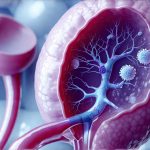Advanced Bladder Pharmacology in Multi-Organ Syndromes
The intersection of bladder function and multi-organ syndromes represents a complex and often overlooked area within medicine. Traditionally, bladder dysfunction has been treated as an isolated issue, focused on urinary symptoms like urgency, frequency, or incontinence. However, increasingly sophisticated understanding reveals the bladder’s intimate connection with other organ systems—particularly the kidneys, gut, brain, and pelvic floor muscles—and how disruptions in one can profoundly impact others. This is especially evident in multi-organ syndromes where systemic inflammation, autoimmune processes, or neurological conditions create a cascading effect on physiological functions. Effective management necessitates moving beyond symptom targeting towards a holistic pharmacological approach that addresses underlying mechanisms and inter-organ relationships.
The challenge lies in the heterogeneity of these syndromes. Conditions like fibromyalgia, irritable bowel syndrome (IBS), chronic pelvic pain syndrome (CPPS) and systemic sclerosis often exhibit overlapping symptoms, making diagnosis difficult and treatment even more so. Patients frequently experience ‘referred pain’ or symptom flares that are not easily attributable to a single organ system. Consequently, pharmacological strategies must be adaptable, personalized, and informed by a deep understanding of both bladder physiology and the specific multi-organ syndrome in question. This article will explore advanced pharmacological concepts applicable to this growing field, focusing on emerging targets and innovative approaches for restoring bladder health within these complex clinical scenarios.
The Neuropharmacology of Bladder Dysfunction
The bladder is not simply a storage sac; it’s an exquisitely innervated organ whose function relies heavily on neurological control. Disruptions in the nervous system are often central to bladder dysfunction observed in multi-organ syndromes. Afferent nerves relay sensory information from the bladder to the spinal cord and brain, while efferent nerves transmit signals back to regulate detrusor muscle contraction and sphincter relaxation. Several key neurotransmitters and neuromodulators play crucial roles: acetylcholine (primarily for detrusor contraction), adenosine triphosphate (ATP, also pro-contractile), norepinephrine (inhibitory influence on bladder), and substance P (involved in pain signaling).
In syndromes like fibromyalgia or IBS, central sensitization can amplify pain signals from the bladder, leading to perceived urgency and frequency even in the absence of significant physiological abnormalities. This underscores the need for therapies targeting central nervous system modulation alongside peripheral interventions. Low-dose tricyclic antidepressants (TCAs) such as amitriptyline are often employed not for their antidepressant effects, but for their ability to modulate pain pathways and reduce neuronal excitability. Similarly, SNRIs (serotonin-norepinephrine reuptake inhibitors) can influence both pain perception and bladder control mechanisms. However, it’s crucial to acknowledge the potential side effect profiles of these medications and carefully monitor patients.
More recently, research has focused on modulating P2X3 receptors – ATP-gated ion channels expressed on afferent nerves in the bladder wall. Overactivation of these receptors is believed to contribute to urgency and frequency. Several selective P2X3 antagonists are currently under investigation, offering a potentially targeted approach with fewer off-target effects than traditional therapies. Furthermore, understanding the role of neuroinflammation – inflammation within the nervous system itself – is gaining traction. Anti-inflammatory agents like low-dose naltrexone (LDN) are being explored as adjuncts to conventional treatments, aiming to reduce neuronal hypersensitivity and restore normal bladder function.
Pharmacological Approaches to Pelvic Floor Dysfunction
Pelvic floor dysfunction frequently accompanies bladder issues in multi-organ syndromes. Conditions like CPPS often involve hypertonicity of the pelvic floor muscles, leading to urinary symptoms and pain. Biofeedback remains a cornerstone of treatment, but pharmacological adjuncts can significantly enhance its effectiveness. Muscle relaxants, such as baclofen or tizanidine, can reduce muscle spasm and alleviate pain, though they carry potential for sedation and other side effects. The key is individualized dosing based on patient response.
- Pelvic floor physical therapy combined with pharmacological intervention offers synergistic benefits.
- Neuromodulation techniques, like sacral nerve stimulation (SNS), are increasingly used in refractory cases, offering a more direct approach to modulating pelvic floor muscle activity. SNS isn’t strictly pharmacological, but often complements medication strategies.
- Emerging research explores the potential of botulinum toxin injections into specific pelvic floor muscles to selectively relax hypertonic areas. This is still considered an off-label use and requires careful patient selection and expertise.
Beyond direct muscle relaxation, addressing underlying pain mechanisms is vital. Gabapentin and pregabalin, originally developed as anticonvulsants, are effective in treating neuropathic pain and can reduce pelvic floor muscle tension by modulating nerve signals. However, their long-term use requires careful monitoring due to potential cognitive side effects. The goal isn’t simply to relax the muscles but to restore a functional balance between contraction and relaxation, optimizing both bladder control and pelvic support.
Targeting Bladder Inflammation & Epithelial Integrity
Chronic inflammation is a hallmark of many multi-organ syndromes, and the bladder itself can be significantly affected. In conditions like interstitial cystitis/bladder pain syndrome (IC/BPS), inflammatory mediators trigger epithelial cell dysfunction and increased permeability, leading to urgency, frequency, and pain. Traditional treatments have focused on symptomatic relief with medications like pentosan polysulfate sodium (Elmiron), although its efficacy remains debated and safety concerns exist regarding retinal pigmentation.
More recently, researchers are investigating therapies targeting specific inflammatory pathways. Mast cell stabilizers such as cromolyn sodium can reduce mast cell activation in the bladder wall, decreasing histamine release and subsequent inflammation. However, intravesical administration is often required for optimal effect. Furthermore, agents that restore epithelial barrier function are gaining attention. Hyaluronic acid (HA) has shown promise in clinical trials, forming a protective layer over the bladder epithelium and reducing permeability.
- Dietary modifications can play a significant role in managing bladder inflammation. Eliminating potential irritants like caffeine, alcohol, spicy foods, and acidic beverages may provide symptomatic relief.
- Supplementation with certain nutrients, such as D-mannose for preventing urinary tract infections (UTIs), or antioxidants to combat oxidative stress, might be beneficial adjuncts, but should always be discussed with a healthcare professional.
The Gut-Bladder Axis & Microbiome Modulation
The emerging field of microbiome research has revealed the profound impact of gut bacteria on distant organs – including the bladder. Dysbiosis (imbalance in gut microbial composition) can contribute to systemic inflammation and alter immune function, potentially exacerbating bladder symptoms. In multi-organ syndromes like IBS and CPPS, a strong link exists between gut health and urinary tract symptoms. Leaky gut syndrome, where increased intestinal permeability allows bacterial products to enter the bloodstream, can trigger an inflammatory response in the bladder.
Pharmacological approaches targeting the gut microbiome are still evolving. Probiotics – live microorganisms intended to confer a health benefit – have shown some promise in modulating immune function and reducing inflammation. However, selecting the right probiotic strain is crucial; not all probiotics are created equal. Prebiotics – non-digestible fibers that promote the growth of beneficial bacteria – can also support gut health.
- Fecal Microbiota Transplantation (FMT) is being investigated as a potential therapy for restoring gut microbial diversity in severe cases, but it remains experimental and requires careful patient selection.
- Antibiotics, while necessary for treating UTIs, can disrupt the gut microbiome and potentially worsen bladder symptoms. Judicious antibiotic use and probiotic supplementation following antibiotic treatment are essential to minimize collateral damage.
- Emerging research explores the use of postbiotics – metabolic byproducts produced by beneficial bacteria – as a more targeted approach to modulating gut function without introducing live organisms.
It’s important to remember that advanced bladder pharmacology in multi-organ syndromes is a rapidly evolving field. A personalized, integrative approach—combining pharmacological interventions with lifestyle modifications, physical therapy, and psychological support—is essential for achieving optimal patient outcomes. Constant reevaluation of treatment plans based on individual response is paramount.





















